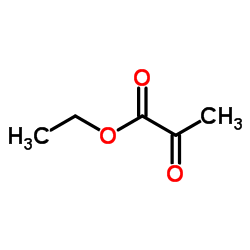Ethylpyruvate

Ethylpyruvate structure
|
Common Name | Ethylpyruvate | ||
|---|---|---|---|---|
| CAS Number | 617-35-6 | Molecular Weight | 116.115 | |
| Density | 1.0±0.1 g/cm3 | Boiling Point | 155.0±0.0 °C at 760 mmHg | |
| Molecular Formula | C5H8O3 | Melting Point | -58 °C | |
| MSDS | Chinese USA | Flash Point | 45 ºC | |
| Symbol |

GHS02 |
Signal Word | Warning | |
|
Effects of ethyl pyruvate on leukocyte-endothelial interactions in the mesenteric microcirculation during early sepsis treatment.
Clinics (Sao. Paulo.) 70 , 508-14, (2015) Experimental studies on sepsis have demonstrated that ethyl pyruvate is endowed with antioxidant and anti-inflammatory properties. This study aimed to investigate the effects of ethyl pyruvate on leukocyte-endothelial interactions in the mesenteric microcircu... |
|
|
HMGB1 enhances immune suppression by facilitating the differentiation and suppressive activity of myeloid-derived suppressor cells.
Cancer Res. 74(20) , 5723-33, (2014) Chronic inflammation often precedes malignant transformation and later drives tumor progression. Likewise, subversion of the immune system plays a role in tumor progression, with tumoral immune escape now well recognized as a crucial hallmark of cancer. Myelo... |
|
|
Ethyl pyruvate significantly inhibits tumour necrosis factor-α, interleukin-1β and high mobility group box 1 releasing and attenuates sodium taurocholate-induced severe acute pancreatitis associated with acute lung injury.
Clin. Exp. Immunol. 172(3) , 417-26, (2013) In this study, we examined the effect of ethyl pyruvate (EP) on pulmonary inflammation in rats with severe pancreatitis-associated acute lung injury (ALI). Severe acute pancreatitis (SAP) was induced in rats by the retrograde injection of 5% sodium taurochola... |
|
|
Radiation protection of the gastrointestinal tract and growth inhibition of prostate cancer xenografts by a single compound.
Mol. Cancer Ther. 13(12) , 2968-77, (2014) Normal tissue toxicity markedly reduces the therapeutic index of genotoxic anticancer agents, including ionizing radiation. Countermeasures against tissue damage caused by radiation are limited by their potential to also protect malignant cells and tissues. H... |
|
|
A role for the NAD-dependent deacetylase Sirt1 in the regulation of autophagy.
Proc. Natl. Acad. Sci. U. S. A. 105 , 3374-3379, (2008) We demonstrate a role for the NAD-dependent deacetylase Sirt1 in the regulation of autophagy. In particular, transient increased expression of Sirt1 is sufficient to stimulate basal rates of autophagy. In addition, we show that Sirt1(-/-) mouse embryonic fibr... |
|
|
Ethyl Pyruvate Emerges as a Safe and Fast Acting Agent against Trypanosoma brucei by Targeting Pyruvate Kinase Activity.
PLoS ONE 10 , e0137353, (2015) Human African Trypanosomiasis (HAT) also called sleeping sickness is an infectious disease in humans caused by an extracellular protozoan parasite. The disease, if left untreated, results in 100% mortality. Currently available drugs are full of severe drawbac... |
|
|
HMGB1: a potential therapeutic target for myocardial ischemia and reperfusion injury.
Int. J. Cardiol. 155(3) , 489, (2012)
|
|
|
Ethyl pyruvate administration suppresses growth and invasion of gallbladder cancer cells via downregulation of HMGB1-RAGE axis.
Int. J. Immunopathol. Pharmacol. 25(4) , 955-65, (2012) High mobility group box B1 (HMGB1)-receptor for advanced glycation end products (RAGE) axis has been previously known to be involved in carcinogenesis and development of multiple malignancies. Some studies have confirmed that Ethyl pyruvate (EP), a potent inh... |
|
|
Effects of high-mobility group box1 on cerebral angiogenesis and neurogenesis after intracerebral hemorrhage.
Neuroscience 229 , 12-9, (2013) Neural stem cells, which reside mainly in the subventricular and subgranular zones of the hippocampus, can regenerate new neuroblasts after various brain insults. Aided by vascular remodeling, these new neuroblasts migrate long distances to injured brain regi... |
|
|
Inhibitory effects of ethyl pyruvate administration on human gastric cancer growth via regulation of the HMGB1-RAGE and Akt pathways in vitro and in vivo.
Oncol. Rep. 27(5) , 1511-9, (2012) The high mobility group box-B1 (HMGB1)-receptor for advanced glycation end-products (RAGE) and the protein kinase B (Akt) pathways play a crucial role in tumorigenesis and development of many malignant tumors. Ethyl pyruvate (EP), a potent inhibitor of HMGB1 ... |